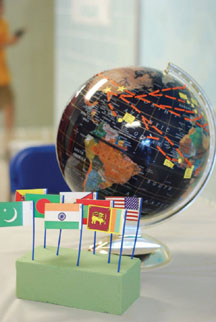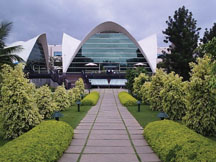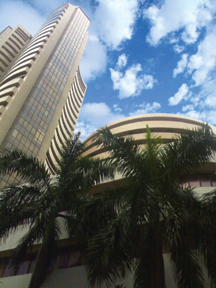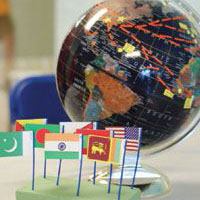Where Do We Stand?
 On the eve of the 59th Republic Day of India, when the entire nation is set to celebrate the occasion with pomp, with a cultural parade and display of military resources at the capital, flag hoisting, and the like all over the nation, it is also a time to review what the nation has achieved, where it lags, and most importantly, where the country stands in comparison to other nations who have gained independence around the same time as India.During the past sixty years, India has come a long way from where it started. It would be quite interesting to compare the progress of other nations to that of India’s progress. An overview and comparison could include nations such as Indonesia and Malaysia, both of which gained independence in the 40s and 50s as well as Japan and China, two nations that have undergone a transformation since the Hiroshima bombing in 1945 and the Chinese Civil War in 1949 respectively.
On the eve of the 59th Republic Day of India, when the entire nation is set to celebrate the occasion with pomp, with a cultural parade and display of military resources at the capital, flag hoisting, and the like all over the nation, it is also a time to review what the nation has achieved, where it lags, and most importantly, where the country stands in comparison to other nations who have gained independence around the same time as India.During the past sixty years, India has come a long way from where it started. It would be quite interesting to compare the progress of other nations to that of India’s progress. An overview and comparison could include nations such as Indonesia and Malaysia, both of which gained independence in the 40s and 50s as well as Japan and China, two nations that have undergone a transformation since the Hiroshima bombing in 1945 and the Chinese Civil War in 1949 respectively.
In terms of politics and governance, India is inarguably the largest democracy in the world, with a well-established multi-party political system in place since independence. Elections are held regularly, and the majority of Indians exercise their rights to elect the government. Political disturbance exists, no doubt, but it has not affected the welfare and development of the country on the whole. The country is plagued by insurgency activities in Kashmir, the Northeast, and the central parts of India.
In a predominantly Muslim country such as Malaysia, which earned its independence in 1957, the early years of the federation were marred by an armed conflict with Indonesia and the expulsion of Singapore. Administratively speaking, more power is vested in the executive branch of government than in the legislative, and the judiciary has been weakened by sustained attacks by the government during the years. Political unrest is evident, especially among non-Bumiputras (son of the soils) as they feel deprived and neglected on account of various policy decisions that limit their actions. Indicators point to a higher incidence of crime and gang-related activities among such people in recent years.
 Indonesia, earned its independence exactly two years before India, is the fourth most populous nation in the world, and is predominantly Muslim. Post 1998, Indonesian political and governmental structures have undergone major reforms. However, separatist movements in the provinces of Aceh and Papua have led to armed conflict, and subsequent allegations of human rights abuses and brutality affect all parties involved. Following a sporadic thirty-year guerrilla war between the Free Aceh Movement (GAM) and the Indonesian military, a ceasefire agreement was reached in 2005. The country has also been threatened by international terrorist attacks.
Indonesia, earned its independence exactly two years before India, is the fourth most populous nation in the world, and is predominantly Muslim. Post 1998, Indonesian political and governmental structures have undergone major reforms. However, separatist movements in the provinces of Aceh and Papua have led to armed conflict, and subsequent allegations of human rights abuses and brutality affect all parties involved. Following a sporadic thirty-year guerrilla war between the Free Aceh Movement (GAM) and the Indonesian military, a ceasefire agreement was reached in 2005. The country has also been threatened by international terrorist attacks.
China, the most populous country in the world, on the other hand, is fast emerging as a global superpower. The nation came into being after the Chinese Civil war in 1949 and has just recently entered the big league, leveraging its vast population, rapidly growing economy, large research and development investments, and status as a declared nuclear weapons state. As a communist state, China went through a series of socioeconomic movements beginning in the late 1950s and continuing in the 1960s with the Cultural Revolution that left much of its education system and economy in shambles. It was only in the late 1990s that a series of political and economic reforms advocated by Deng Xiaoping were implemented and eventually formed the foundation for mainland China’s rapid economic development. On the political front, however, censorship of political speech and information is openly and routinely used to protect what the government considers national security interests. The government has a policy of limiting some protests and organizations that it considers a threat to social stability and national unity, as was the case with the Tiananmen Square protests of 1989. In fact, China is considered as one of the least free countries in the world in terms of press freedoms.
Japan, on the other hand, has shown the world it has what it takes to be the leader as it rose out of the ashes. After the Hiroshima event in 1945, Japan has shown unbelievable development in all spheres. Japan is a constitutional monarchy where the power of the Emperor is very limited and is held chiefly by the Prime Minister of Japan. Since the bombing and the gradual period of resurgence, Japan has engaged in several territorial disputes with its neighbors: with Russia over the South Kuril Islands, with South Korea over the Liancourt Rocks, with China and Taiwan over the Senkaku Islands and the EEZ around Okinotorishima. Japan also faces an ongoing dispute with North Korea over its abduction of Japanese citizens and its nuclear weapons and missile program.
In terms of economy, India has shown tremendous positive development over the last few decades, especially during the early 1990s. The economy has grown in amazing figures, appropriately reflected in the ever-increasing development of the manufacturing and service sector, foreign trade, stock market, and the GDP. In fact, in infrastructure, consumerism, telecommunication and such other segments, India has made significant progress, though there is much left to do.
In comparison, Malaysia was a predominantly agriculture and mining-based economy until the 1970s. After that point, the nation began to imitate the Asian Tigers and committed itself to a transition into an economy that depended more on manufacturing. With Japanese investment, heavy industries flourished and in a matter of years, Malaysian exports contributed to the country’s primary growth. As with other countries affected by the East Asian financial crisis of 1997 and 1998, there was speculative short-selling of the Malaysian currency, the Ringgit, the national stock exchange plummeted to an unprecedented low, foreign direct investment fell at an alarming rate, and capital flowed out of the country. Regardless of cause and effect, rejuvenation of the economy also coincided with massive government spending and budget deficits in the years that followed the crisis. Later, Malaysia enjoyed faster economic recovery compared to its neighbors. In many ways, however, the country has yet to recover to the levels of the pre-crisis era.
In Indonesia, post independence, the economy deteriorated drastically as a result of political instability, a young and inexperienced government, and ill-disciplined economic nationalism, which resulted in severe poverty and hunger. However, in the 1970s oil price increases provided an export revenue windfall that contributed to sustained high economic growth rates. Following further reforms in the late 1980s, foreign investment flowed into Indonesia, particularly into the rapidly developing export-orientated manufacturing sector, and from 1989 to 1997, the Indonesian economy grew by an average of over seven percent. Subsequently, Indonesia was hardest hit by the East Asian financial crisis. Political instability since 1998, slow economic reform, and corruption at all levels of government and business, have also contributed to a slow recovery.
Moving on to the leading economies of Asia, beginning in late 1978, Chinese leadership has been reforming the economy from a Soviet-style centrally planned economy to a more market-oriented economy that is still within a rigid political framework under Communist Party control. The result has been a six-fold increase of GDP since 1978. Chinese economic development is among the fastest in the world, and has been growing at an average annual GDP rate of 9.4% for the past 25 years. Mainland China has a reputation as being a low-cost manufacturer, largely because Chinese corporations can produce many products less expensively than competitors in other parts of Asia or Latin America, and also due to unfavorable exchange rate between the Chinese Yuan and the United States dollar.
 Japan, on the other hand, has been an established economy for a long time, matching steps with the giants like the United States. Close government-industry cooperation, a strong work ethic, mastery of high technology, and a comparatively small defense allocation have helped Japan become the second largest economy. Japan has a large industrial capacity and is home to some of the largest and most technologically advanced producers of motor vehicles, electronic equipment, machine tools, steel and nonferrous metals, ships, chemicals, textiles and processed foods. It is home to leading multinational corporations and commercial brands in technology and machinery. Construction has been one of Japan’s largest industries, with the help of multi-billion dollar government contracts in the civil sector. From the 1960s to the 1980s, overall real economic growth has been called a “miracle” given the 10% average in the 1960s, 5% average in the 1970s, and a 4% average in the 1980s. Growth slowed considerably in the 1990s, largely because of the after-effects of over-investment during the late 1980s and domestic policies intended to wring speculative excesses from the stock and real estate markets. The government has tried to spur economic growth, but they were unable to succeed and were further hampered in 2000 due to the downturn in the global economy.
Japan, on the other hand, has been an established economy for a long time, matching steps with the giants like the United States. Close government-industry cooperation, a strong work ethic, mastery of high technology, and a comparatively small defense allocation have helped Japan become the second largest economy. Japan has a large industrial capacity and is home to some of the largest and most technologically advanced producers of motor vehicles, electronic equipment, machine tools, steel and nonferrous metals, ships, chemicals, textiles and processed foods. It is home to leading multinational corporations and commercial brands in technology and machinery. Construction has been one of Japan’s largest industries, with the help of multi-billion dollar government contracts in the civil sector. From the 1960s to the 1980s, overall real economic growth has been called a “miracle” given the 10% average in the 1960s, 5% average in the 1970s, and a 4% average in the 1980s. Growth slowed considerably in the 1990s, largely because of the after-effects of over-investment during the late 1980s and domestic policies intended to wring speculative excesses from the stock and real estate markets. The government has tried to spur economic growth, but they were unable to succeed and were further hampered in 2000 due to the downturn in the global economy.
However, the economy showed strong signs of recovery after 2005. GDP growth for that year was 2.8%, and in the fourth quarter, the growth rates even rivaled those of the US and European Union during the timeframe. However, it is not that these countries are only making good progress in terms of governance and economy. There are serious issues that are plaguing the nations as well. For India, lack of transparency and corruption, poverty, unemployment, illiteracy, and over-population are still disturbing factors that haunt the nation. Insurgencies, proxy-war with a neighboring country, terrorism, and extremist movements in the North, Northeast and central India are also major concerns.
Even Malaysia, for example, is torn amidst ethnic insurgencies. Facilities are limited among the non-Bhumiputras which causes serious law and order problems. Moreover, non-Muslims experience restrictions in activities such as construction of religious buildings and the celebration of certain religious events in some states. Indonesia, too, is badly affected by global terrorism and remains on the tenterhooks. The country has been ranked 143rd out of 180 countries in terms of corruption. As of 2006, nearly 18% of the population lives below the poverty line, and close to half of the population lives on less than $2 a day.
Even China faces a number of other economic problems, including an aging population and an increasing rural-urban income gap. Although China needs economic growth to spur its development, there is some concern that rapid economic growth has negatively impacted the country’s resources and environment. Another concern is that certain sectors of society are not sufficiently benefiting from China’s economic development. With a population of over 1.3 billion, the country is very concerned about its population growth and has attempted, with mixed results, to implement a strict family planning policy.
For Japan, the primary problem is demographic in nature. Japan has one of the highest life expectancy rates in the world, but the Japanese population is rapidly aging. In 2004, nearly 20% of the population was over the age of 65. The changes in the demographic structure have created a number of social issues, particularly a potential decline in the workforce population and increases in the cost of social security benefits such as the public pension plan. Japan’s population is expected to drop to 100 million by 2050 and to 64 million by 2100.
As we draw a conclusion based on the development (or the lack of it) that we find in East Asian countries and compare to that of India, it could be said that India has moved ahead. In terms of political environment or economy, India can boast of a better position than Malaysia and Indonesia. However, when compared to the giants, Japan and China, India is lagging quite behind and has some serious catching up to do.
So, on the eve of Republic Day, all Indians, politicians, bureaucrats, and common citizens, should take a vow to work towards the welfare of the country and contribute to the wholesome development of their nation. The mission should be to travel the road ahead with a vision to make India a golden country.























